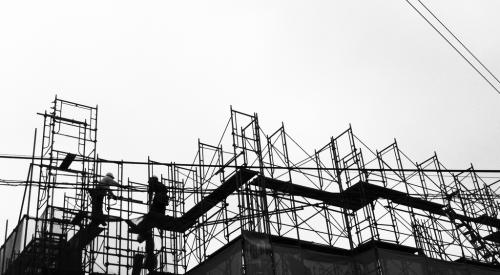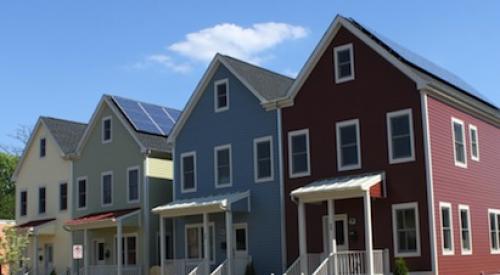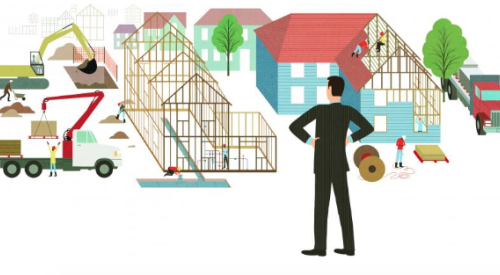
In 2006, Centex was the only Supernova with a higher EBIT margin than in 2005. But don’t look for the erosion of profitability among the Supernovas — including Centex — to stop in 200 |
A look at past Giants Reports, in comparison to this year's, confirms what we suspected: the ebb of the Roaring 2000s. The profit margin on an average housing unit produced by members of the Giant 400 peaked in 2005 and is now trending down.
Our online Giants survey asks respondents for much more than basic information about units closed and revenue from the year just ended. We promise to use their answers only in aggregate, to show trends across the industry and for the categories that show the impact of company size. In one section, for instance, we ask Giants to break down their cost percentages and bottom line profit achieved on an average home sale. The pie charts on these pages show the results by size category for the builders ranked in this year's Giant 400.
Because only five companies make up the Supernovas, we deem that group too small to report aggregate averages without compromising our pledge of confidentiality for individual survey answers. Fortunately, all five are publicly traded, so their profit performance is part of the public record. While we can't show their average cost breakdowns, we are able to show their profit rates in the EBIT (earnings before interest and taxes) margin bar chart provided by Wall Street pros at UBS Investment Bank.
When we compare the aggregates with those of past years, it's easy to see that, at least for home builders, the Roaring 2000s peaked in 2005, as prices went sky-high in many markets, often due to the influence of large numbers of speculative buyers. Keep in mind the companies that make up the Giant 400 ranking are different each year, and the dividing lines among the size categories have also changed over the years. But in general, it's enlightening to compare the cost and profit averages of this year's Giants to those of past years.

Masters of the Universe each have more than $1 billion in revenue, and 13 of the 28 companies are public. Those publics tell Wall Street they have greater purchasing power than private competitors. |
The average profit percentage on the average housing unit closed by the top 400 companies, for instance, was 8.59 percent in 2001 (as shown in our 2002 survey), hit 9.81 percent on homes built in 2003, and peaked at 10.59 percent on homes closed in 2005. This year's survey shows the average profit on an average home for all Giants declined to 10.02 percent in 2006.
The Supernovas' EBIT margins for 2005 and 2006 and cost and profit breakdowns for the other revenue groups still show a correlation between size and profitability, but most of them are losing ground against the peak hit in 2005 — with one exception. This year's Strivers (builders ranked 298 to 400) report average profit on their average home in 2006 at 9.1 percent, compared with the 8.8 percent reported by last year's Strivers for houses closed in 2005.
Meanwhile, the trend line everywhere else is strictly down. The Supernova EBIT average for 2005 was 15.56 percent but declined to 10.2 percent in 2006. Masters of the Universe (Giants 6-33) reported the profit on an average house closed in 2006 at 10.8 percent compared with 16.0 percent for 2005. For the Rich and Famous (Giants 34-139), an average house produced profit of 10.9 percent compared with 12.4 percent the previous year. And Achievers (Giants 140-297) reported average home profit at 10.0 percent for 2006, compared with 10.4 percent for 2005.

Rich and famous builders report the highest profit from an average home sale, 10.9 percent, which is even higher than EBIT average for five Supernovas. |
In the surveys of recent years, we've seen what seemed to be clear indication of a correlation between size and profitability. For instance, last year's average home profit breakdowns showed this progression for 2005: Masters of the Universe, 16.0 percent; Rich and Famous, 12.4 percent; Achievers, 10.4 percent; Strivers, 8.8 percent. This year, the connection of size and profitability is not nearly as clear. The average home's profit contribution (for 2006 closings) reported by the Rich and Famous — 10.9 percent — actually beats the 10.8 percent reported by the Masters of the Universe. And the drop in profit to Achievers at 10.4 percent and Strivers at 9.1 percent is not nearly as pronounced as at the peak of pricing power reached in 2005.
Moreover, a year ago the percentage of average home selling price represented by materials and labor costs was clearly lower in the largest companies. That seemed to show the purchasing power public builders constantly brag about to Wall Street. Here's the progression of materials and labor reported by last year's Giant 400: Masters of the Universe, 45.3 percent; Rich and Famous, 46.3 percent; Achievers, 50.2 percent; Strivers, 53.1 percent. But check the charts on this page and you'll see that this year the gap between Masters and Strivers has narrowed to 5.3 percent, and the Rich and Famous actually beat the Masters by 1.9 percent.
 The gap is narrowing between Achievers’ profit on sale of an average home, 10.0 percent, and those of the much larger builders above in rank. |

Strivers still have lowest reported average home profit and highest materials and labor costs. |












